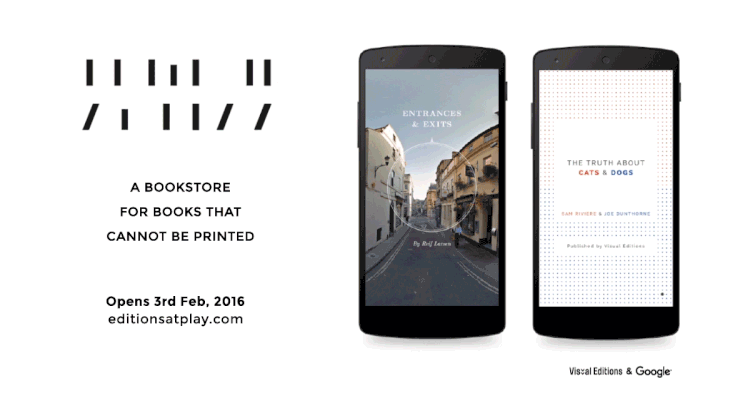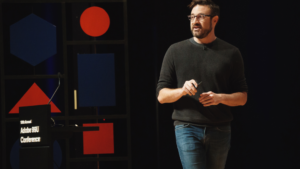99U is a two-day Adobe creative conference that offers pragmatic, real-world insights that transcend various creative sectors. It’s an opportunity for speakers to pull back the curtain on their creative processes and share their road-tested insights.
The topic of this year’s conference was centered on the rally cry: “challenge everything” – yourself, leadership, the status quo, etc. But it became apparent after listening to all of the speakers that a caveat to that was “as long as you do it within the context of our ever-changing perception of reality.” In other words, the pace of change is exponential—we are at a point where we literally can’t keep up with it, so there needs to be a greater level of fluidity in how information and brands are received and how they engage and interact. We need this fluidity because nothing is resolute or finite anymore, everything is constantly being iterated, innovated, disrupted and then self-disrupted.
We’re now confronted with opportunity that is infinite—which is on one hand incredibly exciting, and on the other head, really quite daunting—and the ability to navigate this new landscape, speakers at 99U implored, lies largely in the ability to better understand the way we, as humans, perceive and engage with our ever-evolving realities. This understanding will ultimately help brands craft transformative experiences that expand customers’ outlooks on themselves as well as the world around them.
It’s definitely a heady topic, so to better illustrate the concept, outlined below are a few real-life examples shared at 99U of how this fluidity of experience is already being adopted and applied by brands.

Google Creative Lab
 The first example is from a speaker Tea Uglow, who is the “Experimental Person in Charge” (awesome job title) at Google Creative Lab. The topic of her talk really centered on this concept of “non-linear storytelling for a non-contiguous world” and her whole point was that the way we deal with information today is static and linear—we start at point A, move to point B, point C and so on. Like movies and books, everything has a beginning, a middle and an end. But in real life, that’s not necessarily how information works. Information has multiple perspectives and reality itself is a complex thing that exists in 3 different dimensions, so in reality, we should approach information and content from a variety of angles.
The first example is from a speaker Tea Uglow, who is the “Experimental Person in Charge” (awesome job title) at Google Creative Lab. The topic of her talk really centered on this concept of “non-linear storytelling for a non-contiguous world” and her whole point was that the way we deal with information today is static and linear—we start at point A, move to point B, point C and so on. Like movies and books, everything has a beginning, a middle and an end. But in real life, that’s not necessarily how information works. Information has multiple perspectives and reality itself is a complex thing that exists in 3 different dimensions, so in reality, we should approach information and content from a variety of angles.
Tea and her team have been experimenting with applied ways we can move away from this flat, static means of information sharing and storytelling, and one of those ways is through reimagining a centuries old technology—a book. Tea and her team asked themselves: is this how a book would exist if it was invented today? They thought, well, no. So they created something called Editions At Play —an online platform that takes the universal components of storytelling and reimagines how they come to life through modern technology in a way that is interactive, dynamic and most importantly, non-linear.
The heart of the idea revolves around how we can take a universal story concept or storytelling components, and dimensionalize them through new perspectives. Opening up the opportunity for people to experience the same, familiar thing—like a book—in new ways that meet them where they are, how they are, with content that can be engaged with or explored however best aligns to the way they want to experience it.
Meow Wolf
 The second example is from Vince Kadlubek, the CEO of Meow Wolf. The net net of his talk was how in the coming years, alternate realities will become the biggest product consumers will be seeking, so brands and companies today need to understand their significance in order to understand how to plan for, design for and create them in the future.
The second example is from Vince Kadlubek, the CEO of Meow Wolf. The net net of his talk was how in the coming years, alternate realities will become the biggest product consumers will be seeking, so brands and companies today need to understand their significance in order to understand how to plan for, design for and create them in the future.
Vince and his team recognized a deep desire people have to experience art outside of merely looking at pieces at arm’s length in a rigid and sterile gallery—a desire to touch, feel and interact with the art rather than holding it on a pedestal. So Meow Wolf took this knowledge and created mind blowing, transformative experiences through immersive art installations. The art experiences they designed were so vastly different from modern art galleries—from current reality—they feel like an alternate reality. And by being so unfamiliar and so foreign, these immersive art installations allow each person experiencing them to come to a transformative realization: “If the world can be different than it has been, then I can be different than I have been.” Powerful stuff.
And what it so impressive about the “alternate realities” Meow Wolf was successful in achieving, and something we as brands can all learn from and leverage, is the fact that they didn’t need to employ VR, AR or super innovative technology, all they needed was to understand the deepest desires of their customers—of human beings—and leverage that insight to create fluid, iterative experiences that grow and mature with the desires of their audience to present them with a reality beyond their realm of expectations.
At the highest level, 99U spurred curiosities around how brands (and we as people) need to stop taking information, experiences and the world at face value, as something that is fixed and limited. We have the power to be fluid in the way we approach a problem and its solution. To affect change and to create truly transformative experiences that people can connect with on a deeper level—ones that align with the idyllic realities they will continue to crave over the coming years.